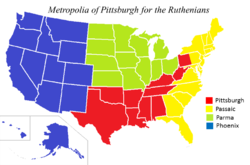|
Metropolis of Pittsburgh (Ruthenian Greek Catholic Church)
 The Metropolis of Pittsburgh is a sui juris metropolitan see of the Ruthenian Greek Catholic Church that is located in the United States of America and Canada. The Ruthenian Greek Catholic Church is one of 23 sui juris ('self governing') Eastern Catholic particular churches in the Catholic Church that is in full communion with the Holy See. The metropolis uses the Byzantine Rite in its liturgies. It was erected as a metropolis (archdiocese) by Pope Paul VI in 1969. The metropolis has jurisdiction over those communities that originated (in terms of their ancestry) from the regions of Carpathian Ruthenia, Slovakia, Hungary and the former Yugoslavia. Worshipers come from several Byzantine Catholic groups: Rusyn Americans, Slovak Americans, Hungarian Americans, and Croatian Americans.[1] In 2022, governance of the Exarchate of Saints Cyril and Methodius of Toronto in Canada passed to the metropolis of Pittsburgh from the Slovak Greek Catholic Church.[2] The Ruthenian Greek Catholic Church does not have a unified organization. OrganizationThe canonical territories of the Metropolitan Province are:
Although Rusyn Americans constitute the majority of members of the metropolis, the Church has ordinary jurisdiction over the faithful of certain Churches within the Slavic Tradition of the Byzantine Rite that do not have an established hierarchy in the United States, specifically those of the Hungarian, Slovak, and Croatian Greek-Catholic Churches. When the Ruthenian Catholic Church in Europe was under atheistic Communist rule, and because of persecution, unable to organize publicly, the impossibility of regular communication with it meant that the distant American Metropolia, unable to be treated as a normal metropolia of an Eastern Rite Catholic Church (canons 133–139 of the Code of Canons of the Eastern Churches), has been treated as a sui iuris Metropolitan Church (canons 155–173 of the Code of Canons of the Eastern Churches). The Holy See's Annuario Pontificio has, however, always listed it not as a separate particular Church but as a Metropolia of the Ruthenian Church. HistoryIn 1924, an Apostolic Exarchate was created for the Ruthenian-Rite Catholics in the USA, with ancestry from the regions of Carpathian Ruthenia and other parts of the former Kingdom of Hungary. In 1963, the Apostolic Exarchate was divided in two parts, each transformed into a diocese (eparchy): one centered in Pittsburgh and the other in Passaic. Both remained under direct jurisdiction of the pope, and were officially defined as observing the Ruthenian Rite.[3] Ruthenian Catholic Metropolis of MunhallIn 1969, the Eparchy of Pittsburgh was raised in rank and renamed as the Archeparchy of Munhall, and in the same time a metropolitan province was created and named the Ruthenian Catholic Metropolis of Munhall, encompassing also the Eparchy of Passaic and the newly created Eparchy of Parma. The new Metropolis and all of its eparchies were officially defined as observing the Ruthenian Rite.[4] Byzantine Catholic Metropolis of PittsburghIn 1977, the Archeparchy and the Metropolis were renamed and redefined from Munhall of the Ruthenians to Pittsburgh of the Byzantines,[5] and thus continued as the Byzantine Catholic Metropolis of Pittsburgh. In 1981, the Eparchy of Van Nuys was created and officially defined as observing the Byzantine Rite.[6] In 2009, its seat was moved from Van Nuys to Phoenix, and its name was changed to the Eparchy of Phoenix. In January 2007, Metropolitan Basil Schott, Archbishop of Pittsburgh promulgated a major revision of two of the major Divine Liturgies (Chrysostom and Basil) of the Byzantine Catholic Church. SeminaryThe church's Byzantine Catholic Seminary of SS. Cyril and Methodius, established in 1950, is located on Pittsburgh, Pennsylvania's Observatory Hill. In addition to the training of priests, it offers a program in Deacon Formation as well as a Cantor's Institute. List of Bishops and Apostolic Administrators
See also
References
Sources
External links
|